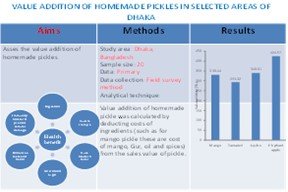Value addition of homemade pickles in selected areas of Dhaka, Bangladesh
Abstract
The pickles are popular food item in Bangladesh. Different types and kinds of pickles are sold by the vendors in the roadside those are processed by themselves at their home. This study has been conducted to assess the value addition of homemade pickles. The four homemade pickles (mango pickle, tamarind prickle, jujube pickle and elephant apple pickle) were selected for this study. The study was conducted in Gulshan, Dhanmondi, Uttara and Mirpur of Dhaka in Bangladesh. This study was based on primary data. Primary data were collected through face-to-face interview method in the month of mid-September to mid-October 2019. Data were collected from 20 vendors (selected conveniently) and 60 consumers (selected purposively) of homemade pickles. Descriptive statistics (mainly mean, percentage) was used to analyze the data. Value additions of homemade pickles were calculated by deducting the cost of production from the selling price of pickle which can be found from the value addition tables. The study found that the vendor’s added value of Tk. 330.44 ($3.94) to one kg raw mango, Tk.293.32 ($3.49) to one kg tamarind, Tk.340.01 ($4.05) to one kg jujube and Tk.425.57 ($5.07)to one kg elephant apple by processing to make pickle if it is ignored the value addition of other ingredients. In percentage term, it was 182.67 to 448.90 according to pickles. So, this is a productive activity creating form utility for the consumers that can contribute to the economy of Bangladesh.
Keywords:
Dhaka, Homemade pickles, Value additionDownloads
References
Ackah, M. E., Gyamfi, T., Anim, A. K., Osei, J., Hasnsen, K. J., & Agyemang, O. (2011). Socioeconomic profile, knowledge of hygiene and food safety practices among street-food vendors in some parts of Accra-Ghana, Journal of Food Safety, 13, 191–197.
Anderson, D. P., & Hanselka, D. (2009). Adding value to agricultural products. Available at: http://tinyurl. com/y86n69g3
Banga, R., (2013). Measure value in global value chain, regional value chains, unit for economic cooperation and integration among developing countries (ECIDC).
Bhowmik, S., (2010). Street vendors in the global urban economy,Routledge: Taylor & Francis, New Delhi, India.
Bulla, R. S., (2010). Documentation of pickles and development of dehydrated mango pickle mix. MSc Thesis, University of Agricultural Science, Dharwad, India.
Coltrain, D., Barton, D., & Boland, M. (2000). Value added: opportunities and strategies. Available at: http:// tinyurl.com/ycoxv5m9
Islam, N., Arefin, M. S., Nigar, T., Haque, S. N., Haq, K. I., Emran, M. T. A., & Nazrul, T. (2017). Street food eating habits in Bangladesh: a study on Dhaka city. International Journal of Management and Development Studies, 6(9), 49-57.
Jassim, H. A., Ahmed, A. F., & Ghilan, M. S. (2020). The value added for the manufacturing of potato chips and the factors affecting them within the value chain of potato crop for the spring season of 2018, Journal of food Distribution Research 32(1), 1-4.
Khairuzzaman, M., Chowdhury, F. M., Zaman, S., Mamun, A. A., & Bari, M. L. (2014). Food safety challenges towards safe, healthy, and nutritious street foods in Bangladesh, International Journal of Food Science, 1-9 [accessed on 1 August 2021: https://www.ncbi.nlm.nih.gov/pmc/articles/PMC4745531/pdf/IJFS2014-483519.pdf].
Mamun, S., Alam, S., Zaher, M. A., & Huq, A. K. O. (2020). Food safety knowledge, attitudes and behavior of street food vendors and consumers in Dhaka City. Bangladesh Journal of Microbiology, 37(2), 48-51.
Medical News Today, Medi Lexicon International (2019). Are Pickles Good for You? Benefits of Fermented Foods. https://www.medicalnewstoday.com /articles/325124
Monika, S., Kumari, A., Angmo, K., & Bhalla, T.C. (2016). Traditional pickles of Himachal Pradesh. Indian Journal of Traditional Knowledge,15, 330–336.
Muzaffar, A. T., Huq, I., & Mallik, B. A. (2009). Entrepreneurs of the streets: an analytical work on the street food vendors of Dhaka city, International Journal of Business and Management, 4(2), 80–88.
Nayga, R., Nichols, J., & Jones, L. (1999). Notes on value-added food and agriculture in Texas. Unpublished, Texas A&M University.
Nelson, A. (2021). “Pickles: Nutrition, Benefits, Risks, & Preparation.” WebMD, WebMD (https://www.webmd.com/food-recipes/health-benefits-pickles).
Nichols, J., & Goodwin, H.L. (1993). "Value- Added: What is it?" Speech at the 30th annual meeting of the Texas Section of the American Society of Agricultural Engineers, College Station, Texas, October 20.
Okello, N., Beevers, L., Douven, W., & Leentvaar, J. (2009). The Doing and Un-Doing of Public Participation during Environmental Impact Assessments in Kenya. Impact Assessment and Project Appraisal, 27, 217-226, https://doi.org/10.3152/146155109X465940
Omitti, J., Otieno, D., McCullogh, E., & Nyanamba, T. (2007). Strategies to promote market –oriented smallholder agriculture in developing countries: A case of Kenya, African Association of Agricultural Economists, Ghana Conference 2007.
Rane, S. (2011). Street vended food in developing world: hazard analyses, Indian Journal of Microbiology, 51(1), 100-106.
Ratti, C. (2001). Hot air and freeze-drying of high-value foods: a review. Journal of Food Engineering, 49, 311–319.
Science Direct (2019). “Pickling.” Pickling-an Overview (https://www.sciencedirect.com/topics/food-scirnce/pickling; viewed on 12.9.2019).
Tronstad, R. (1999). Why value-added agriculture? Tucson, AZ: University of Arizona, Department of Agricultural and Resource Economics. http:/ag.arizona.edu/arec/va/whyvalueadded.html

Published
How to Cite
Issue
Section
Copyright (c) 2023 Agriculture and Environmental Science Academy

This work is licensed under a Creative Commons Attribution-NonCommercial 4.0 International License.

